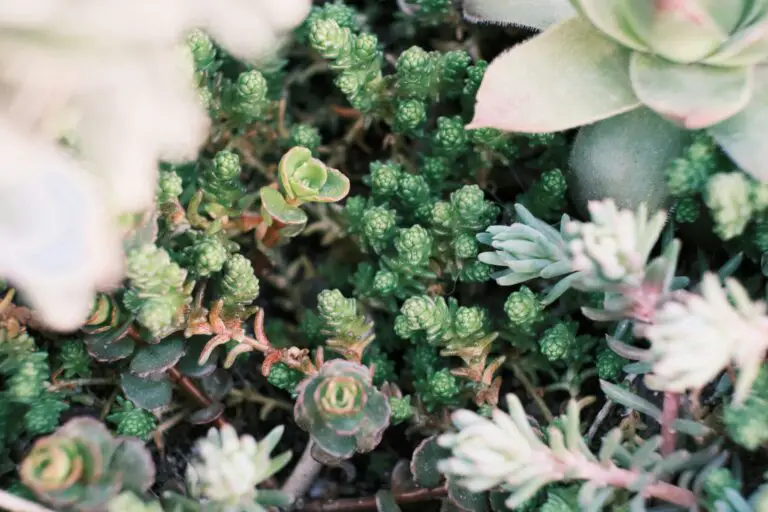Introduction to Sedum Reflexum
Welcome to the fascinating world of Sedum reflexum, also known as Jenny’s stonecrop or blue stonecrop. This succulent plant, with its distinctive chubby leaves and star-shaped flowers, isn’t just pleasing to the eye; it holds a story grounded in the rugged terrains of its origin. Have you ever wondered where exactly these sturdy plants hail from, or why knowing a plant’s homeland is as crucial for your garden as a compass is for a sailor?
The answer to the first question takes us on a journey back to the rocky landscapes and mountainous regions of Europe, where Sedum reflexum thrives in its native habitat. It weathers the storms and basks in the high-altitude sunlight, a testament to its resilient nature and an inspiration to gardeners and conservationists alike. Real-life examples of its adaptability are found in gardens worldwide, where it’s celebrated for its ability to endure and charm.
Understanding the native habitat of plants is more than a trivial pursuit; it’s a cornerstone of effective gardening and vital to preserving biodiversity. For those with a green thumb, replicating the native conditions of plants like Sedum reflexum can be the difference between a thriving garden and a botanical blunder. Conservation efforts hinge on this knowledge, as we learn from alpine beauties that teach us about resilience and adaptation.
So next time you spot a Sedum reflexum soaking up the sun in a rock garden or gracing the solitude of an alpine slope, take a moment to appreciate its humble origins. It not only adds aesthetic value but also carries a rich legacy from its native cradle, offering us insights into the resilience of life in the most challenging environments.
Unveiling the Native Habitat of Sedum Reflexum
Embark on a journey to the rugged mountain ranges and experience the remarkable resilience of Sedum reflexum. Known for its robust nature, this alpine stonecrop hails from the craggy landscapes of Europe’s rocky outcrops. Let’s traverse the areas where this hardy plant feels most at home, painting a picture of the wild terrains that cradle the existence of this verdant succulent.
Imagine steep slopes, kissed by the chill of high altitude, where the air is crisp and the soil scant. Here, in the embrace of alpine and subalpine zones, Sedum reflexum thrives, basking in the serene beauty of its native climatic haven. Its tenacity isn’t just a testament to survival; it captures the essence of adaptation in the most challenging of environments.

From the sun-drenched crannies of the Pyrenees to the limestone ledges of the Alps, Sedum reflexum is a master of conservation. In these regions, where the climate flirts with the extremes, this plant has evolved to capture every drop of moisture, each ray of sunlight. And it doesn’t just endure but flourishes, crafting lush carpets of greenery that drape over the stones like nature’s finest tapestry.
Yet, the existence of Sedum reflexum isn’t solitary; it’s a component of a more extensive symphony that plays out across the eco-stage. For firsthand insights, explore how Sedum stonecrop brings life to gardens and green roofs. This succulent’s presence supports a diverse array of fauna, from pollinating insects to foraging birds, each playing a vital role in the ecological dialogue of their shared alpine home.
As we peel back the layers, Sedum reflexum’s native habitat tells a story of ecological harmony, a place where the robust mingle with the delicate, and life finds a way amidst the stones. It’s a narrative that continues to captivate and inspire, reminding us of the enduring spirits dwelling within the silent strength of the mountains.
Sedum Reflexum’s Adaptations to Its Native Environment
Imagine a plant that can hold its own against the scorch of the sun, shrug at drought, and come out of it all looking vibrant and verdant – meet Sedum reflexum, a master of adaptation. Its far-stretching roots, tracing back to the cragged heights and rocky terrains of Europe, have imparted it with a resilience that gardeners and plant enthusiasts admire. Let’s delve into the gritty details and explore how this alpine succulent thrives where others merely survive.
I often quip that Sedum reflexum comes with a built-in survival kit. With succulent leaves that are akin to miniature reservoirs, it bunkers down water for the proverbial rainy day – or rather, the days when rain is a distant memory. Imagining each leaf as a tiny canteen isn’t far from the truth; they’re plump with stored moisture that sees the plant through dry spells. What’s more, these leaves are more than just water carriers. They’re covered in a waxy substance that reduces evaporation, a bit like having a built-in sunscreen that also conserves water!
Now, let’s talk about the root of the matter. Sedum reflexum doesn’t just skate by with minimalist water hoarding; its roots dig deep into the earth, vigorously seeking out moisture that other, more skittish plants might overlook. These roots entwine through rocky crevices and soils that would be inhospitable to less hardy flora, ensuring that Sedum reflexum stays anchored and hydrated even when the environment is less than accommodating.
Have you ever seen a sedum plant growing in what seems like an impossible place? Alongside cliff faces, between craggy rocks, or in sparse soil? That’s not just the plant’s “can-do” spirit; it’s biological innovation at work. Take a closer look, and you’ll witness the marvel of this plant’s ability to colonize areas where other plants wouldn’t dare to tread. It spreads with ease, thanks to its tenacious nature and robust rooting system, which also makes it a gardener’s ally for preventing soil erosion and covering ground with living green tapestries.
Without the chance to experience video footage showcasing Sedum reflexum’s adaptations, it’s still clear as daylight how finely tuned this plant is to its ancestral home lands. The evolutionary craftsmanship that has shaped this stonecrop enables it to not just endure the challenges of its native habitat but flourish.
Yearning for more insights on nurturing these resilient beauties? Your curiosity can be sated with our detailed guide on unlocking growth timelines for stonecrop plants, where you can learn even more about the vivacity of the Sedum lineage. Exploring the intricacies of Sedum reflexum care isn’t just about keeping these plants alive; it’s about understanding the tapestry of life that allows them to continue thriving generation after generation.
The Historical Significance of Sedum Reflexum in Native Regions
Unearthing the storied past of Sedum reflexum, also known as Jenny’s Stonecrop, reveals a tapestry woven with cultural and medicinal threads. Native to mountainous terrains and rocky outcrops across Europe, this hardy plant has garnered the admiration and utilization of many local communities for centuries.
Imagine strolling through a quaint Alpine village and spotting the distinctive fleshy leaves of Sedum reflexum peeking out from stony walls and rustic roofs. It’s not solely a matter of quaint aesthetics; traditionally, these plants were meticulously selected and used by healers. The leaves of Sedum reflexum were, and in some regions, still are, a staple in folk medicine, trusted for their purported anti-inflammatory properties. Villagers would crush the leaves to release the plant’s juice, which was then applied to soothe rashes and skin irritations—a testimony to the plant’s embeddedness in the daily life and well-being of its native populace.
Beyond the realm of health, Sedum reflexum also played a part in local cultural practices. In certain areas, this alpine stonecrop was associated with folklore and superstition. It wasn’t uncommon for people to plant it on roofs, believing it to be a protective charm against lightning and witchcraft. The resilience and vigor of Sedum reflexum, thriving in harsh conditions, were seen as a symbol of protection and strength, embodying the steadfast spirit of the native people who nurtured it.
One cannot discuss the historical significance of Sedum reflexum without mentioning the simple, yet profound, role it played in everyday life. This succulent was often kept in home gardens, its presence a humble reminder of nature’s capacity to persist and flourish even in the face of adversity. For a more vivid depiction of how Sedum reflexum fits into the gardening practices and lives of past generations, watch this insightful video.
Delving into the history of Sedum reflexum is like unearthing a buried treasure of ethnobotanical knowledge. While researching more about its traditional uses, it’s rather disheartening to find that much of this knowledge is at the brink of being forgotten. If interested, you can explore for yourself the rich background and legacy of this remarkable plant. Each leaf of Sedum reflexum tells a story—a narrative of resilience, of nature’s intrinsic link with human culture, and the silent yet significant role it plays in the continuity of local heritage.
Conservation Status of Sedum Reflexum
Exploring the alpine slopes and rocky outcrops, one can discover the hardy, evergreen charm of Sedum reflexum, also known as ‘Jenny’s Stonecrop.’ Native to these lofty heights, this unsung hero of the plant world quietly thrives, yet its existence is not without its challenges. The current conservation status of this tenacious flora is, in fact, a poignant narrative of survival against increasingly insurmountable odds.
As a plant inhabited by the rugged terrain of the Old World, particularly thriving in the mountains of Europe, Sedum reflexum has made an art out of resilience. However, its native habitat faces the daunting threats of habitat destruction and the omnipresent specter of climate change. Urban encroachment, agricultural expansion, and tourism are reshaping the landscape, slowly eroding the stonecrop’s natural abode. In response, conservationists are raising the clarion call to protect these valuable ecosystems.
Imagine the picturesque scene: a sheer mountain cliff bathed in sunlight, adorned with the succulent leaves of Sedum reflexum as they bask in their alpine home. Yet, with temperatures rising, these hardy plants have to wage a silent battle for survival. The intricate balance of alpine ecosystems is delicate; a warming climate alters snow cover, seasonal water availability, and can disrupt the entire life cycle of this remarkable species.
It is in this context that the survival story of Sedum reflexum transcends mere botanical interest and becomes a symbol of a global struggle. This stonecrop, while not currently listed as endangered, epitomizes the plight of countless species that depend on stable climatic conditions and undisturbed habitats. Active conservation efforts, policy changes, and increased awareness are the essential lifelines that may ensure the future flourishing of these green jewels in their high-altitude kingdoms.

Through local conservation initiatives, we can begin to address the imminent threats. Real-life examples such as rewilding projects and habitat restoration efforts in Europe paint a picture of practical hope. Aided by the dedication of ecologists and community-led movements, the integrity of Sedum reflexum‘s native realm can be preserved.
Balance is key, and as stewards of the Earth, we are tasked with the noble mission to maintain that equilibrium. In the grand tapestry of the natural world, Sedum reflexum may play a small part, but it’s a part woven with the threads of ecological connection and global environmental health. Observing its conservation status is not merely a look into a botanical matter; it is a reflection of our own collective capacity to nurture and protect the fragile biodiversity upon which our planet’s well-being hinges.
Cultivating Sedum Reflexum Outside Its Native Range
In the quest to add diversity and resilience to our garden landscapes, Sedum reflexum, commonly known as ‘Jenny’s Stonecrop,’ has captivated the hearts of gardeners and landscapers alike. This alpine succulent, hailing from the rocky foothills and crags of Eurasia, requires certain conditions to flourish when distanced from its native soil. Emulating these conditions can yield a lush carpet of this perennial favorite, even in the most unexpected of locales.
The key to successfully cultivating Sedum reflexum outside its native range lies in recreating an Alpine-like environment. That means well-draining soil is a must, as its roots are accustomed to the rocky, fast-draining slopes of its mountainous home. Some gardeners, inspired by the plant’s resilience, have taken to creating raised beds filled with a gritty mix of soil and stone, akin to a miniature alpine garden.

When we talk about light exposure, Sedum reflexum basks in the full glory of the sun in its natural habitats. To mimic these conditions, finding a spot that receives ample sunlight throughout the day can encourage robust health and spur those signature starry blooms that make this stonecrop a stunner. In Amsterdam, a group of urban gardeners transformed a sunny rooftop into a thriving sedum sanctuary, setting a prime example of urban ecological innovation.
Temperature-wise, where is Sedum reflexum native to impacts its hardiness. Although originating from the cool embrace of alpine regions, it adjusts remarkably well to a range of temperatures, including frosty winters. However, it is the combination of cold and wet that can spell disaster for this plucky plant. Thus, ensuring proper water drainage and avoiding ‘wet feet’ becomes crucial, especially in areas with heavy snowfall or rainfall.
Adapting Sedum reflexum to new environs is not just an exercise in horticultural prowess; it’s also a commitment to biodiversity. By introducing this adaptable succulent to non-native gardens, we invite a treasure trove of pollinators. Butterflies, bees, and other beneficial insects often find solace in the nectar-rich blossoms, as seen in the bustling gardens of an elementary school in Oregon, where these plants have become living classrooms showcasing the synergy between flora and fauna.
Embracing the rugged charm of Sedum reflexum in our gardens, far from its ancestral roots, stands as a testament to the adaptability of nature and the ingenuity of those with a green thumb. It’s a dance of diligence and dedication, a balance of science and soul, and, ultimately, a lesson in the beauty of growth, wherever we may plant our roots.
Sedum Reflexum’s Role in Ecological Landscaping
Imagine strolling through a garden where each plant plays a vital role in creating a vibrant ecosystem — this is the essence of ecological landscaping, and Sedum reflexum is becoming a star player in this green ensemble. Native to mountainous areas of Europe and often found thriving in rocky crevices, this hardy stonecrop brings its alpine resilience to gardens seeking biodiversity and ecological benefits.
Adaptable and Unfussy: A Perfect Ground Cover
Sedum reflexum, with its fleshy leaves and cascading habit, offers more than just aesthetic appeal. Its adaptability to various soil conditions and low water requirements makes it a perfect candidate for ground cover in eco-friendly landscaping. Picture it: dense mats of Sedum reflexum providing a lush, green carpet requiring minimal upkeep — a real-life example of beauty meeting functionality.
Bees Buzzing and Butterflies Fluttering
But it’s the pollinators that truly buzz with excitement for this succulent’s star-shaped flowers. By planting Sedum reflexum, gardeners create a haven for bees, butterflies, and other beneficial insects, making a tangible contribution to local biodiversity. Each bloom becomes a bustling hub of activity, echoing the native alpine meadows where these insects thrive.
From the Alps to Your Backyard
The story of Sedum reflexum begins in the rugged landscapes of the Alps, where it thrives despite challenging conditions. This survivor’s attitude is what enables it to contribute so remarkably to sustainable gardens. In dry, nutrient-poor soils where other plants may falter, Sedum reflexum rises to the occasion, transforming barren spaces into lush, green oases.
The Architect of Eco-Gardens
Landscapers and eco-gardeners champion Sedum reflexum for its ability to stabilize soil and conserve water — the hallmarks of an ecologically sound gardening practice. Its thick mat-forming growth habit keeps the soil in place, preventing erosion and retaining moisture. This not only nurtures the plant itself but also supports surrounding flora, illustrating how it lays the groundwork for a thriving garden ecosystem.
To see Sedum reflexum in action and gather more insights into caring for this ecological gem, let’s take a look at a video that provides tips and inspiration for integrating this succulent into outdoor spaces:
Cool Refuge in Hot Climates
In regions plagued by scorching summers, Sedum reflexum offers a cooling effect. Its verdant foliage reflects sunlight and provides shade to the soil, creating microclimates that serve as cool refuges for soil-dwelling organisms. It’s a living umbrella, a small-scale but significant modifier of local conditions that benefits the whole garden.
In Conclusion…
While we won’t wrap up just yet, it’s clear that Sedum reflexum is not just a pretty face in the garden. It’s a resilient, multifunctional plant that lends itself to ecological landscaping with ease. Its native traits — drought resistance, soil stabilization, and wildlife support — work in harmony to elevate the biodiverse potential of any garden. Embracing Sedum reflexum is like inviting the resilient spirit of its alpine homeland into our own backyards, and in turn, reaping the rewards of a balanced and thriving ecosystem.
Frequently Asked Questions
Embarking on a botanical odyssey to uncover the origins of the hardy Sedum reflexum, many enthusiasts wonder about the native habitat that shaped such a resilient alpine stonecrop. So, let’s dig into the bedrock of queries that cultivate conversations in gardens far and wide!
What are the native roots of Sedum reflexum?
Tracing the lineage of Sedum reflexum, it’s no surprise to find it hailing from the mountainous terrains across Europe. Imagine it nestled within nooks of rugged landscapes, thriving amid the challenging European alpine and subalpine zones—its natural bastion. This green pioneer voyaged far from its home turf, yet its origin story forever intertwines with these stoic ranges.
As steadfast as its origin, Sedum reflexum boasts a remarkable hardiness, rated from zones 5 to 8. This means whether you’re tending to a garden in the brisk winds of Maine or in the mild climes of Oregon, this stonecrop stands sentinel through frost and fair weather alike. No wonder this plant is a beloved feature in rock gardens and rooftop greenery!
Delving into ideal growing conditions.
Enticed by the allure of keeping a piece of alpine wonder? Sedum reflexum asks for simplicity: give it sunshine that mimics its native altitudes and well-draining soil to emulate the rocky retreats of its ancestors. Overhead, the sun beams down, encouraging growth as the sedum’s bright green, needle-like leaves eagerly catch every glint of light.
Cultivating curiosity: Propagation techniques.
Propagation mirrors nature’s own artistry. A symphony of processes that signal the plant’s innate desire to endure and spread. A dream for aspiring green thumbs, Sedum reflexum propagates readily. Simply snip a sprig, let it callous for a day or two like a mini-mountaineer acclimatizing, and then nestle it into soil as if planting tiny trees on your very own rock-clad hillside.
From alpine origins to your doorstep, Sedum reflexum brings rugged beauty and resilience, asking but a slice of nature to call its own. Now you’re in the know, ready to foster a fragment of alpine heritage right in your garden!


